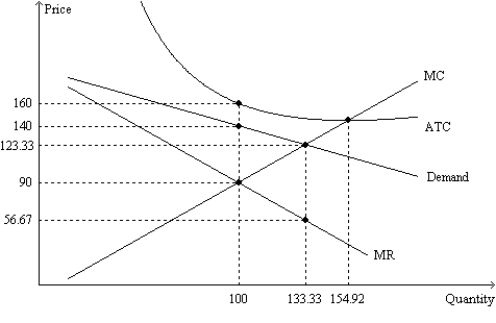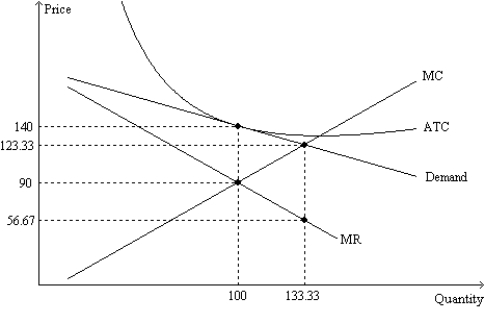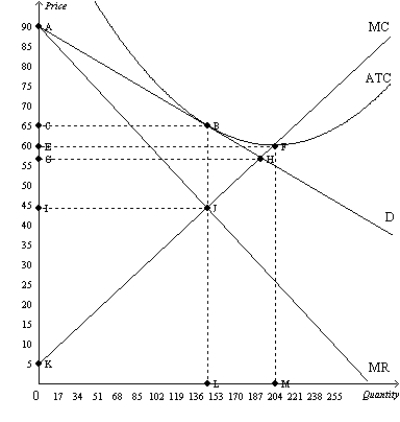A) Firms in monopolistic competition and monopoly can earn economic profits in both the short run and the long run.
B) Both perfectly competitive and monopolistically competitive firms are price takers.
C) Both a monopolistically competitive industry and a monopoly are characterized by a very small number of (or one) firm(s) .
D) Firms can easily enter a perfectly competitive or monopolistically competitive industry.
F) A) and B)
Correct Answer

verified
Correct Answer
verified
Multiple Choice
Although monopolistically competitive markets offer consumers a wide variety of differentiated products, there may still be insufficient variety if
A) there are large fixed costs in the market.
B) there are no barriers to entry in the market.
C) the business-stealing externality is present in the market.
D) the government does not impose regulations on the market.
F) All of the above
Correct Answer

verified
Correct Answer
verified
Short Answer
Firms that sell highly differentiated consumer goods, such as over-the-counter drugs, soft drinks, breakfast cereals, and dog food, typically spend between 10 and 20 percent of revenue for
Correct Answer

verified
Correct Answer
verified
Multiple Choice
Scenario 16-3
Peter operates an ice cream shop in the center of Fairfield. He sells several unusual flavors of organic, homemade ice cream so he has a monopoly over his own ice cream, though he competes with many other firms selling ice cream in Fairfield for the same customers. Peter's demand and cost values for sales per day are given in the table below. (Everyone who purchases Peter's ice cream buys a double scoop cone because it's so delicious.)
 -Refer to Scenario 16-3. How much profit will Peter earn each day if he chooses the price and quantity that maximize his profit?
-Refer to Scenario 16-3. How much profit will Peter earn each day if he chooses the price and quantity that maximize his profit?
A) $176
B) $208
C) $225
D) $352
F) B) and C)
Correct Answer

verified
Correct Answer
verified
Multiple Choice
Because a monopolistically competitive firm has some market power, in the long-run the price of its product exceeds its
A) average revenue.
B) average total cost.
C) marginal cost.
D) None of the above is correct.
F) B) and C)
Correct Answer

verified
Correct Answer
verified
Multiple Choice
A monopolistically competitive market is like both a competitive market and a monopoly in that
A) all three market structures feature easy entry by new firms in the long run.
B) firms in all three market structures maximize profit by producing an output level where marginal revenue equals marginal cost.
C) firms in all three market structures produce the welfare-maximizing level of output.
D) All of the above are correct.
F) A) and D)
Correct Answer

verified
Correct Answer
verified
Multiple Choice
Table 16-4
This table shows the demand schedule, marginal cost, and average total cost for a monopolistically competitive firm.
 -Refer to Table 16-4. How much profit will this firm earn when it chooses its output to maximize profit?
-Refer to Table 16-4. How much profit will this firm earn when it chooses its output to maximize profit?
A) a $12 loss
B) an $8 profit
C) a $25 profit
D) a $32 profit
F) All of the above
Correct Answer

verified
Correct Answer
verified
Short Answer
Suppose there is a market in which the firms hold the following market shares: 25%, 20%, 18%, 15%, 8%, 7%, 4%, 2%, 1%. What is the concentration ratio for this market?
Correct Answer

verified
Correct Answer
verified
Multiple Choice
Entry by new firms into a monopolistically competitive market
A) creates additional consumer surplus.
B) imposes a positive externality on existing firms.
C) leads to the same externalities that are observed when new firms enter a perfectly competitive market.
D) increases the demand for existing firms' products.
F) B) and C)
Correct Answer

verified
Correct Answer
verified
True/False
When a firm in a monopolistically competitive market earns zero economic profit, its product price must equal marginal cost.
B) False
Correct Answer

verified
Correct Answer
verified
Multiple Choice
The market for novels is
A) perfectly competitive.
B) a monopoly.
C) monopolistically competitive.
D) an oligopoly.
F) B) and D)
Correct Answer

verified
Correct Answer
verified
Multiple Choice
When a monopolistically competitive firm is in long-run equilibrium,
A) marginal revenue is equal to marginal cost.
B) average total cost is minimized.
C) marginal revenue is tangent to average total cost.
D) All of the above are correct.
F) C) and D)
Correct Answer

verified
Correct Answer
verified
Multiple Choice
To maximize its profit, a monopolistically competitive firm
A) takes the price as given and chooses its quantity, just as a competitive firm does.
B) takes the price as given and chooses its quantity, just as a colluding oligopolist does.
C) chooses its quantity and price, just as a competitive firm does.
D) chooses its quantity and price, just as a monopoly does.
F) None of the above
Correct Answer

verified
Correct Answer
verified
Multiple Choice
Monopolistic competition differs from perfect competition because in monopolistically competitive markets
A) there are barriers to entry.
B) all firms can eventually earn economic profits.
C) each of the sellers offers a somewhat different product.
D) strategic interactions between firms are important.
F) C) and D)
Correct Answer

verified
Correct Answer
verified
Multiple Choice
A monopolistically competitive firm is currently producing 20 units of output. At this level of output the firm is charging a price equal to $20, has marginal revenue equal to $12, has marginal cost equal to $12, and has average total cost equal to $18. From this information we can infer that
A) the firm is currently maximizing its profit.
B) the profits of the firm are negative.
C) firms are likely to leave this market in the long run.
D) All of the above are correct.
F) None of the above
Correct Answer

verified
Correct Answer
verified
Multiple Choice
Figure 16-10
The figure is drawn for a monopolistically-competitive firm.  -Refer to Figure 16-10. In response to the situation represented by the figure, we would expect
-Refer to Figure 16-10. In response to the situation represented by the figure, we would expect
A) some of the firms that are currently in the market to exit.
B) the demand for this firm's product to increase, assuming this firm does not exit.
C) this firm's profit to move from its current value toward zero.
D) All of the above are correct.
F) All of the above
Correct Answer

verified
Correct Answer
verified
Multiple Choice
Advertising that uses celebrity endorsements is most likely intended to
A) increase elasticity of demand for the advertised product.
B) reduce the ability of markets to allocate resources efficiently.
C) provide a signal of product quality.
D) be useful only for psychological effects.
F) B) and D)
Correct Answer

verified
Correct Answer
verified
Multiple Choice
Figure 16-9
The figure is drawn for a monopolistically-competitive firm.  -Refer to Figure 16-9. As the figure is drawn, the firm is in
-Refer to Figure 16-9. As the figure is drawn, the firm is in
A) a short-run equilibrium but it is not in a long-run equilibrium.
B) a long-run equilibrium but it is not in a short-run equilibrium.
C) a short-run equilibrium as well as a long-run equilibrium.
D) neither a short-run equilibrium nor a long-run equilibrium.
F) A) and C)
Correct Answer

verified
Correct Answer
verified
Multiple Choice
Monopolistically competitive markets differ from perfectly competitive markets due to (i) the number of sellers. (ii) the barriers to entry. (iii) the product differentiation among the sellers.
A) (i) only
B) (iii) only
C) (i) and (iii) only
D) (ii) and (iii) only
F) C) and D)
Correct Answer

verified
Correct Answer
verified
Multiple Choice
Figure 16-14  -Refer to Figure 16-14. Which of the following represents the excess capacity of this firm?
-Refer to Figure 16-14. Which of the following represents the excess capacity of this firm?
A) BJ
B) GH
C) LM
D) There is no excess capacity.
F) None of the above
Correct Answer

verified
Correct Answer
verified
Showing 321 - 340 of 587
Related Exams